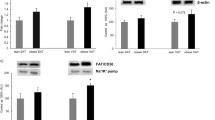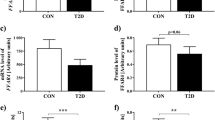Abstract
The primary purpose of this investigation was to determine whether adipose tissue glycerol 3-phosphate dehydrogenase activity is associated with human obesity. The data presented in this paper indicate that the glycerol 3-phosphate dehydrogenase activity in adipose tissue from morbidly obese subjects is approximately 2-fold higher than from lean individuals. Moreover, positive correlation between adipose tissue glycerol 3-phosphate dehydrogenase activity and body mass index (BMI) (r = 0.5; p < 0.01) was found. In contrast, the adipose tissue fatty acid synthase (FAS) and ATP-citrate lyase (ACL) activities in morbidly obese patients are significantly lower than in lean subjects. Furthermore, negative correlation between adipose tissue FAS activity and BMI (r = –0.3; p < 0.05) as well as between ACL activity and BMI (r = –0.3; p < 0.05) was found.
These data indicate that elevated glycerol 3-phosphate dehydrogenase might contribute to the increase of triacylglycerol (TAG) synthesis in obese subjects, however, fatty acids necessary for glycerol 3-phosphate esterification must be derived (because of lower FAS and ACL activities) mainly from TAG in circulating lipoproteins formed in liver (VLDL), and/or from the intake with food (chylomicrons).
The conclusion is, that the enhanced activity of glycerol 3-phosphate dehydrogenase, and hence the generation of more glycerol 3-phosphate in adipose tissue offers a novel explanation for increased TAG production in adipose tissue of obese subjects.
Similar content being viewed by others
References
Large V, Hellstrom L, Reynisdottir S, Lonnquist F, Erikson P, Lannefelt L, Arner P: Human beta-2 adrenoceptor gene polymorphism are highly frequent in obesity and associate with altered adipocyte beta-2 adrenoceptor function. J Clin Invest 100: 3005-3013, 1997
Large V, Reynisdottir S, Langin D, Fredby K, Klannemark M, Holm C, Arner P: Decreased expression and function of adipocyte hormone-sensitive lipase in subcutaneous fat cell of obese subjects. J Lipid Res 40: 2059-2066, 1999
Binnert C, Pachiaudi C, Beylot M, Hans D, Vandermander J, Chantre P, Riou J, Laville M: Influence of human obesity on the metabolic fate of dietary long and medium chain triacylglycerols. Am J Clin Nutr 67: 595-601, 1998
Kelley D, Goodpaster B, Wimg R, Smoneau J: Skeletal muscle fatty acid metabolism in association with insulin resistance, obesity and weight loss. Am J Physiol Endocrinol Metab 277: E1130-E1141, 1999
Berger JJ, Barnard RJ: Effect of the diet on fat cell size and hormone sensitive lipase activity. J Appl Physiol 87: 227-232, 1999
Zeleweski M, Swierczynski J: Comparative studies on lipogenic enzyme activities in liver of human and some animals species. Comp Biochem Physiol 95: 469-472, 1990
Moustaid N, Jones BH, Taylor W: Insulin increases lipogenic enzyme activity in human adipocytes in primary culture. J Nutr 126: 865-870, 1996
Swierczynski J, Goyke E, Wach L, Pankiewicz A, Kochan Z, Adamonis W, Sledzinski Z, Aleksandrowicz Z: Comparative study of the lipogenic potential of human and rat adipose tissue. Metabolism 49: 594-599, 2000
Diraison F, Dusserre E, Vidal H, Sothier M, Beylot M: Increased hepatic lipogenesis but decreased expression of lipogenic gene in adipose tissue in human obesity. Am J Physiol Endocrinol Metab 282: E46-E51, 2002
Kent C, Carman G M, Spence MW, Dowhan W: Regulation of eukaryotic phospholipid metabolism. FASEB J 5: 2258-2266, 1991
Ryall RL, Goldrick RB: Glycerokinase in human adipose tissue. Lipids 12: 272-277, 1977
Hillgartner FB, Salati LM, Goodridge AG: Physiological and molecular mechanism involved in nutritional regulation of fatty acid synthesis. Physiol Rev 75: 47-76, 1995
Tepperman HM, Tepperman J: Adaptative changes in α-glycerophosphate generating enzymes in rat liver Am J Physiol 214: 67-72, 1968
Zolnierowicz S, Swierczynski J, Zelewski L: Isolation and properties of glycerol-3-phosphate oxidoreductase from human placenta. Eur J Biochem 154: 161-166, 1986
Peterson GL: A simplification of the protein assay method of Lowry et al. which is more generally applicable. Anal Biochem 83: 346-356, 1977
Brown LJ, Koza RA, Marshall L, Kozak LP, MacDonald MJ: Lethal hypoglycemic ketosis and glyceroluria in mice lacking both the mitochondrial and the cytosolic glycerol phosphate dehydrogenase. J Biol Chem 277: 32899-32904, 2002
Zezulak KM, Grenn H: The generation of insulin-like growth factor-I sensitive cells by growth hormone action. Science 233: 551-553, 1986
Dogli A, Dani C, Fredrikson G, Grimaldi P, Ailhaud G: Acute regulation of insulin-like growth factor-I gene expression by growth hormone during adipose cell differentiation. EMBO J 6: 4011-4016, 1987
Montague CT, Prins JB, Sanders L, Digby JE, O'Rahilly: Depot-and sex-specific differences in human Leptin mRNA expression. Implication for the control of regional fat distribution. Diabetes 46: 342-347, 1997
Salans LB, Knittle JL, Hirsch J: The role of adipose cell size and adipose tissue insulin sensitivity in the carbohydrate intolerance of human obesity. J Clin Invest 47: 153-165, 1968
Alton DJ, Bray GA: Metabolism of alfa-glycerol phosphate in human adipose tissue in obesity. J Clin Endocrinol Metab 27: 1573-1580, 1967
Bray GA: Lipogenesis in human adipose tissue: Some effects of nibbling and gorging. J Clin Invest 51: 537-548, 1972
Bray GA: Effect of the diet and triiodothyronine on the activity of snglycerol-3-phosphate dehydrogenase and on the metabolism of glucose and pyruvate by adipose tissue of obese patients. J Clin Invest 48: 1413-1422, 1969
Fabry P, Fodor J, Hejl Z, Braun T, Zvolankova K: The frequency of meals: Its relationship to overweight, hypercholesterolemia, and decreased glucose tolcrance. Lancet 2: 614-615, 1964
Belfiore F, Borzi V, Napoli E, Rabuazzo AM: Enzyme related to lipogenesis in the adipose tissue of obese subjects. Metabolism 25: 483-493, 1976
Berman D, Rogus E, Busby-Whitehead J, Katzel L, Goldberg A: Predictors of adipose tissue lipoprotein lipase in middle-age and older men: Relationship to leptin and obesity, but not cardiovascular fitness. Metabolism 48: 183-189, 1999
Ong JM, Kern PA: Effect of feeding and obesity on lipoprotein lipase activity, immunoreactive protein, and messenger RNA levels in human adipose tissue. J Clin Invest 84: 305-311, 1989
Author information
Authors and Affiliations
Rights and permissions
About this article
Cite this article
Swierczynski, J., Zabrocka, L., Goyke, E. et al. Enhanced glycerol 3-phosphate dehydrogenase activity in adipose tissue of obese humans. Mol Cell Biochem 254, 55–59 (2003). https://doi.org/10.1023/A:1027332523114
Issue Date:
DOI: https://doi.org/10.1023/A:1027332523114




